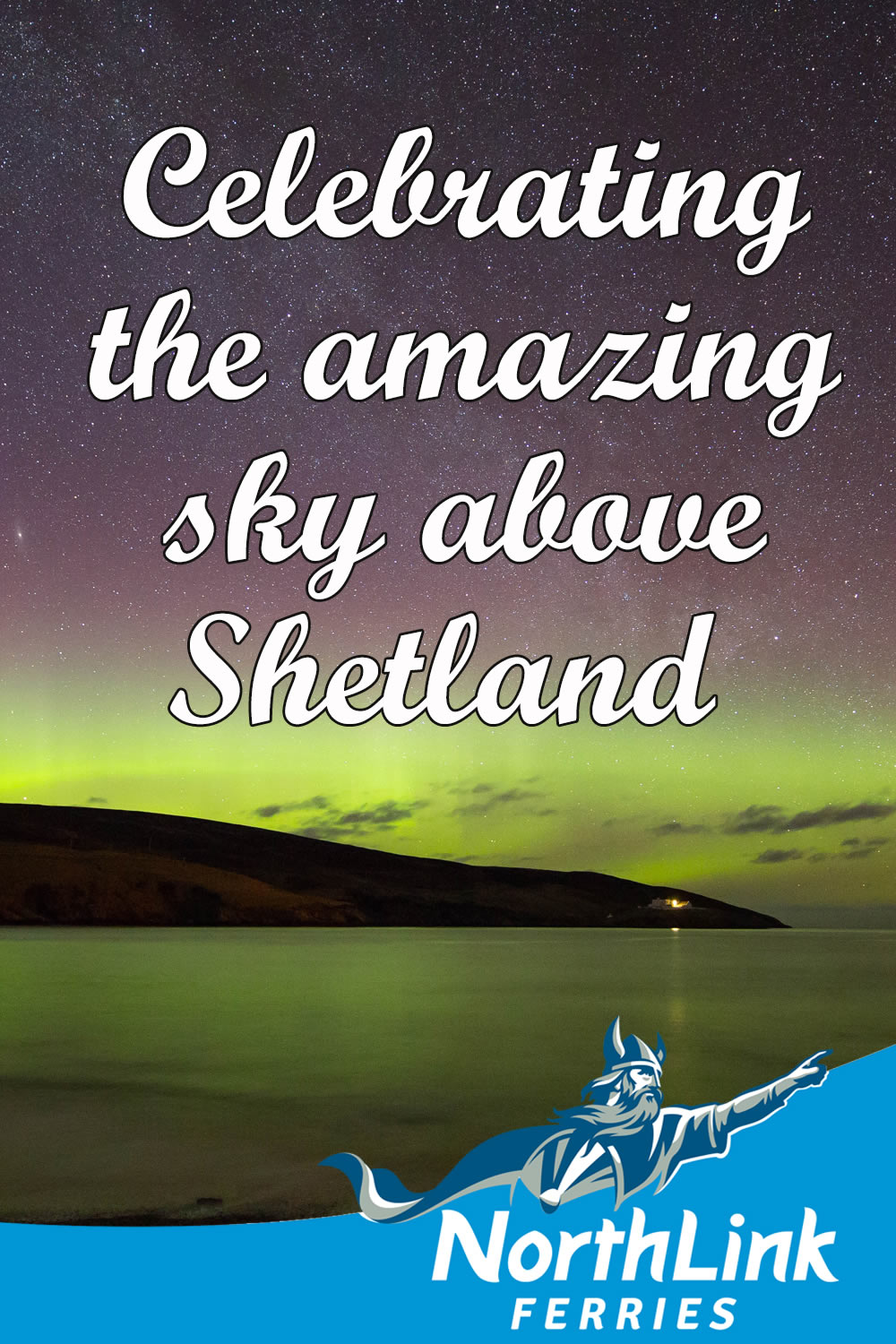Celebrating the amazing sky above Shetland
With clear skylines and less light pollution than other places in the UK, Shetland is a great place from which to observe the skies. Wild Skies Shetland is a charity based in Unst, the most northerly island in the UK, which aims to celebrate the magnificence of the skies all the year round.
We are keen to celebrate the wonders of our amazing skies, in particular looking at how the sky has influenced our history, dialect and understanding of science.
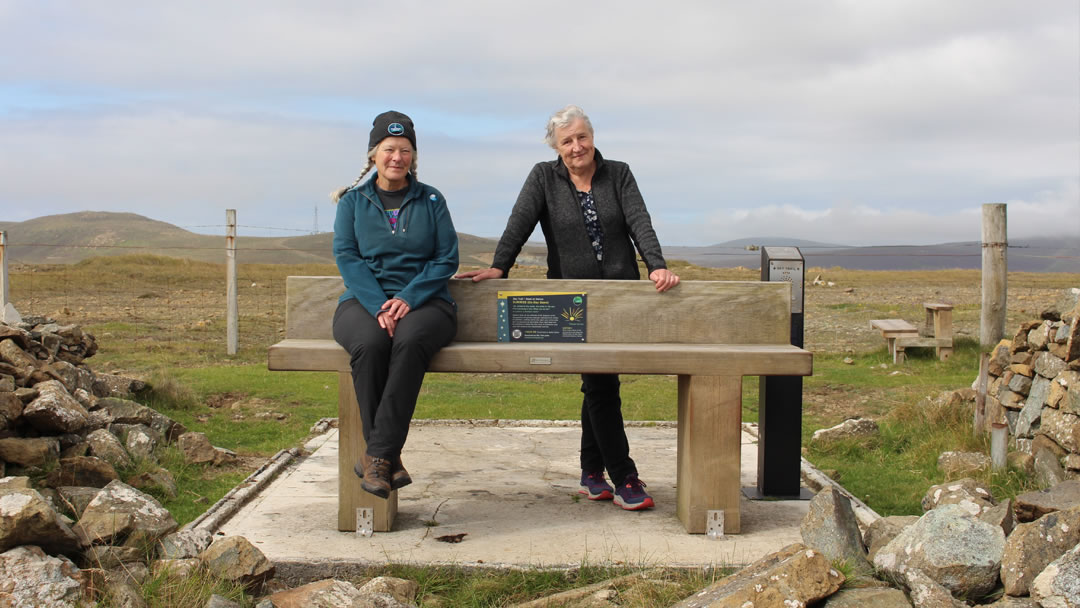
Jane Macaulay, the secretary of Wild Skies Shetland, told us more.
Q. What is Wild Skies Shetland?
A. Wild Skies Shetland showcases the marvels and enormity of the skies above the island of Unst, and down through Shetland. We set up trails, and organise events, including a photo exhibition.
Q. What is the aim of Wild Skies Shetland – why is the sky important?
A. We have many aims. We are keen to celebrate the wonders of our amazing skies, in particular looking at how the sky has influenced our history, dialect and understanding of science.
From an economic point of view, we would like to encourage visitors to come outwith the main summer season and into the shoulder seasons. By that I mean come before the 1st of May, and after the 30th of September – ideally people can come and experience winter skies with us.
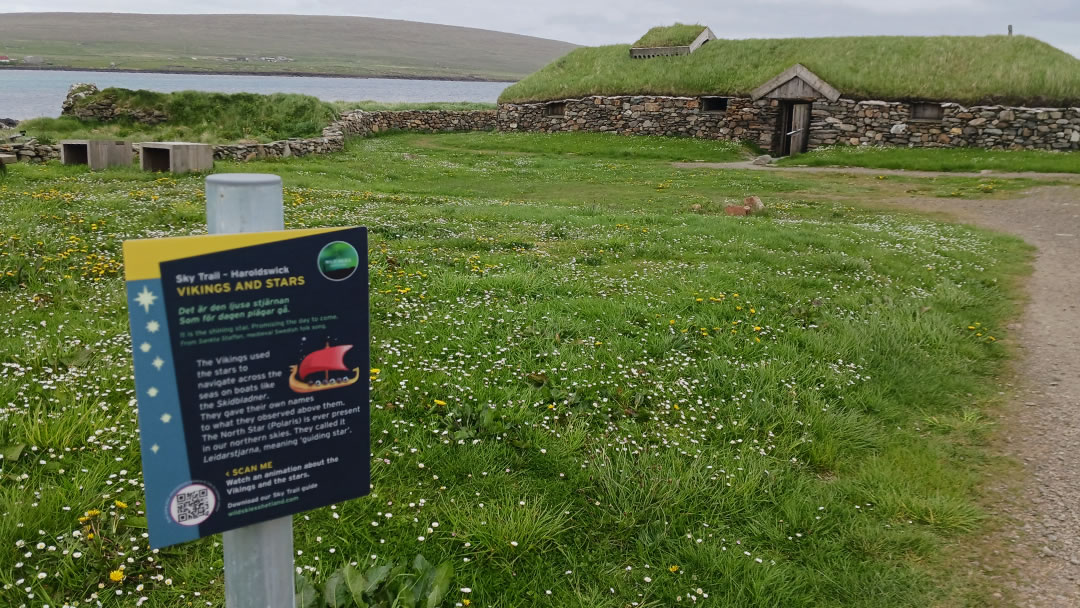
Unst is a small island with a population of just over 600. The RAF was in Unst for a little over 60 years and that brought people and income to the island. When I arrived in 1988 there were about 1,300 folk living here. When the RAF left, we lost a third of the population of the island and half the roll of the school.
Wild Skies Shetland also recognises the importance of being outside, in nature, especially since Covid had such a negative effect on the mental health of so many people. Being outside in a beautiful environment and being filled with awe by the beauty of the skies is a most excellent antidote to gloom.
Unst is a fantastic island with many interesting things to see and we get lots of visitors. However, most of the tourists come at much the same time. The summer is extremely busy! This means all our service industries, whether it be accommodation, food, or shops are at capacity. Unst could really do with more visitors coming in the winter. We hope the Sky Trail will encourage that.
Q. Tell us a bit more about the Sky Trail.
A. The Sky Trail is an island wide trail. Unst is about 12 miles long and 3 miles wide and we have 13 sky stops. Each one has a different theme connected to the sky.
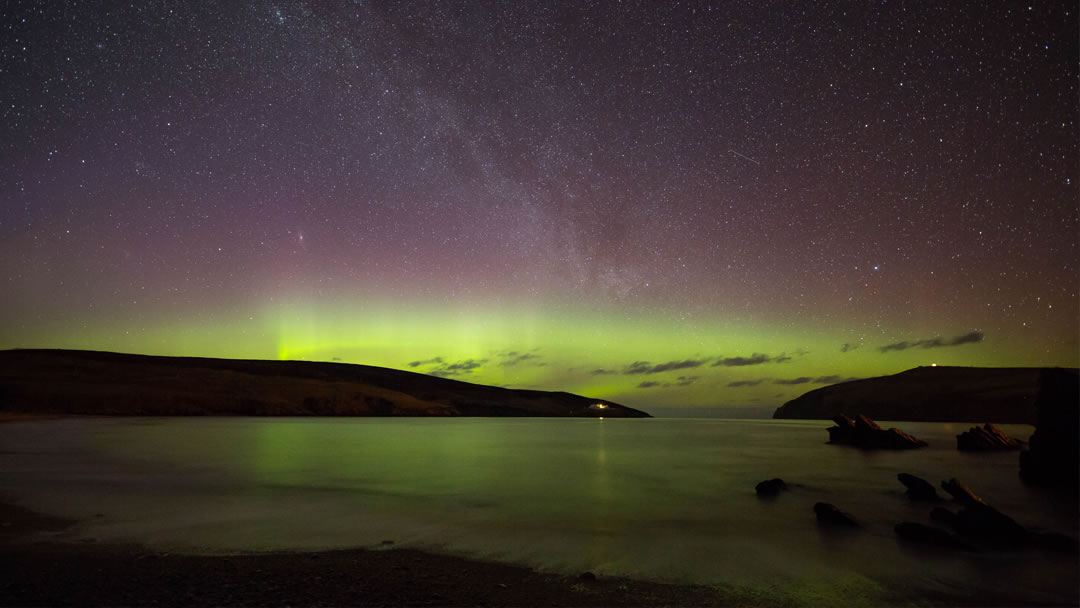
One of the themes is the Mirrie Dancers (aurora borealis or the northern lights). That stop is at the top of Saxa Vord, which is the highest hill in Unst, and boasts a solar rechargeable audio bench with specially written harp music, by a local professional harpist Sunita Stanislaw. Her music has been inspired by the Mirrie Dancers. There is also a story of the aurora told by the author Tom Morton, a Shetland based journalist. This stop has an unbelievable view and is one if the attractions in a Promote Shetland film featuring Kate Humble which is available on YouTube.
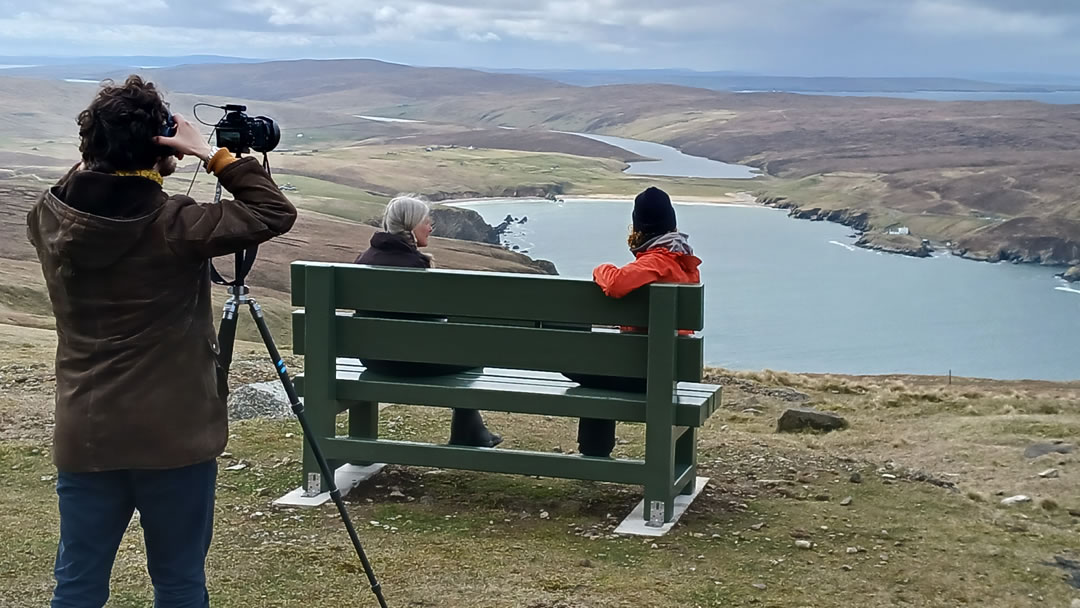
At the car park before walking over the National Nature Reserve of Hermaness, there is a Wild Skies audio post by the interpretation centre that is all about storms and wild weather. This is because, just around the corner and on a steep sided rock, sits the Muckle Flugga or ‘the impossible lighthouse’ which has been critically important since the late 1850s in keeping sailors and their ships safe in wild weather.
Amongst the other 11 sites there are 4 more audio posts which tell you about a variety of other aspects of the sky, for example the simmer dim (midnight sun) and weather sayings read in the dialect. All the other sky stops have panels with sky related information and a QR code to access more background information from our website for the more curious visitor. You can also do the whole sky trail from the comfort of your own home, anywhere in the world here. All the audio of poems, stories and both traditional and more modern music is there on the website for your enjoyment. Of course, visiting Unst in person would be a far more exciting option, if that is possible.
Q. When I first heard about Wild Skies Shetland, I imagined it might only be about the night sky. Is that not the case?
A. No – we do not only focus on night skies. Each stop on the Sky Trail will feature a different aspect of the sky. It will be of relevance to visitors all year round, day and night.
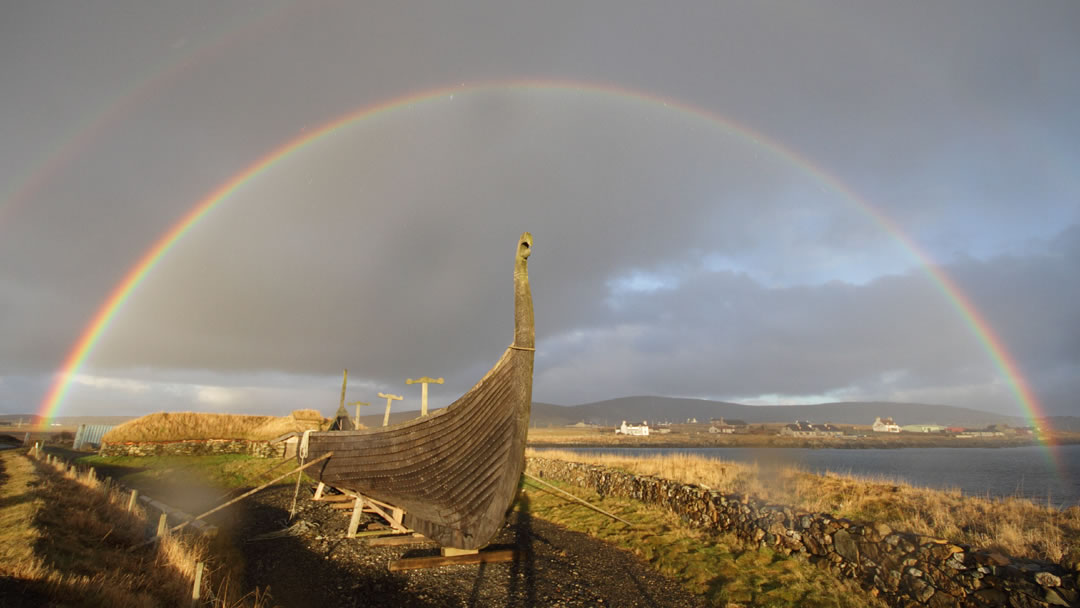
From the summer of 2021, we have had an exhibition of Shetland sky photos in the Unst Heritage Centre. We made a point of showing some incredibly beautiful daytime skies and sky phenomena, as well as the Milky Way and the aurora.
Although it is not all about night-time astronomy, the adventure and excitement of seeing the aurora borealis and the Milky Way in the winter months will definitely be an attraction for many.
Q. Unst is relatively easy to get to – the Sky Trail sounds like it will be a great draw.
A. Yes, that is our aim. We would love to be able to bring more visitors here, all the year round, and keep them here for longer. Unst has an enormous visitor offer already – beautiful beaches, amazing wildlife including otters, rare birds and cetaceans – whales and dolphins – a small and perfectly formed Heritage Centre and Boat Haven, and a leisure centre for wet and windy days. We also have a gin distillery – Shetland Reel. We have 3 very well stocked shops, UnstFest, a 9 day summer festival, and 2 Up Helly Aas – Viking fire festivals – in February.
To give you more idea about the sky trail: the sky-stop at Belmont (as you get off the inter-island ferry) is all about the tides between Unst and Yell, which is one of the fastest tidal runs in the UK. There is a tidal turbine on the seabed of Bluemull Sound. If you are at the north end of Yell with an electric car, you can charge your car on Cullivoe Pier using electricity powered by the tidal race!
In the south-east of Unst, at Framgord, there is a Viking longhouse and an ancient chapel and graveyard from the 12th century. The audio post tells the story of how the Norse Gods threw a toe into the sky and it became a cluster of stars. It would almost be as if you are being told a folklore tale by the fireside, whilst looking out on this beautiful view, with the reminder that people have lived here for centuries. The traditional music at this stop will encourage you to dance a Saint Bernard’s waltz on the grassy outcrop by the sea.
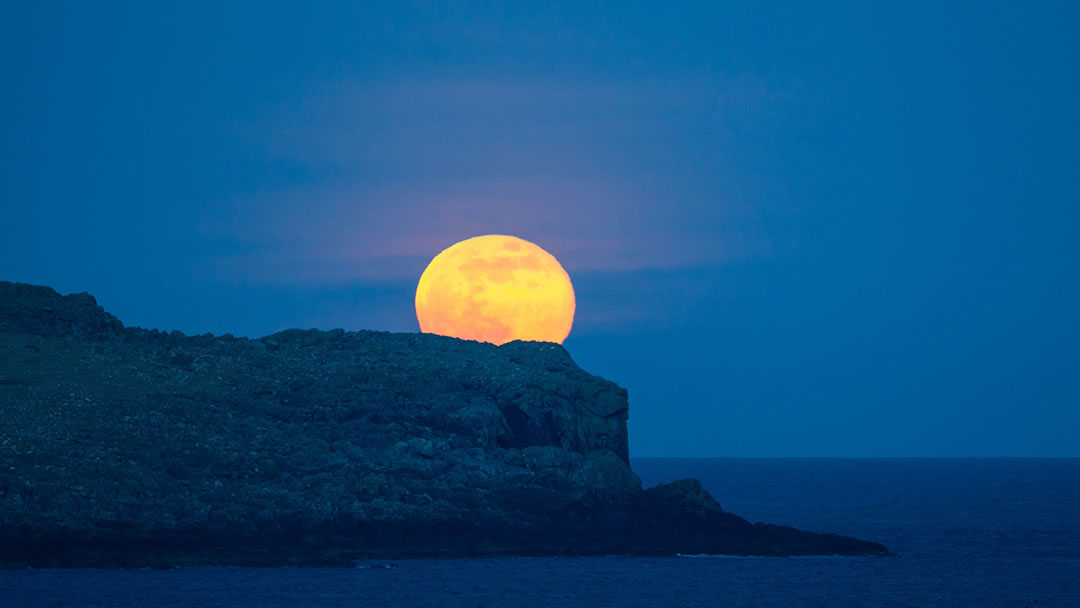
We also have, as part of Viking Unst, a replica Viking Longship ‘Skidbladner’ and a Longhouse at Haroldswick. One of our sky stops is there and it describes how the Vikings navigated using the stars. The Vikings saw the stars quite differently to the Greco-Roman way that we interpret the stars today and a short, animated film, available on the website and through the QR code on site, explains about Viking mythology and navigation.
Q. How do visitors (who might not be aware of Wild Skies Shetland) find out about the Sky Trail?
A. Please visit our website, our Facebook page or our YouTube channel. Once you arrive in Shetland there are leaflets available from the Shetland tourist information office at the Market Cross in Lerwick, or you can download one before you come. We also have information panels inside the NorthLink Ferries terminal in Lerwick.
Once on the road north we are in the process of erecting three beautiful ‘gateway’ panels on the journey to Unst. The first one will be at Toft, where you catch the first crossing from the Shetland mainland. The second will be at Gutcher in Yell, where you catch the ferry to Unst. The third will be at Belmont, where you arrive in Unst. The panels will give people a taster of what to expect from Wild Skies Shetland and the Sky Trail.
Q. What else will Wild Skies Shetland cover?
A. We have a seasonal Planetary Trail in the north of Unst. This is a walk across the solar system. Each planet was designed by friends of Wild Skies, so Mercury has been knitted and Neptune is made of glass. The sun has been made by nursery pupils at the Baltasound School. Then the artwork was transferred onto information boards, one for each planet. The planets have been set at relative distances from each other. Walking the span between planets can be quite eye opening, and you can walk the whole solar system in less than half an hour! In the summer, at the end of the trail, you can have a picnic on Pluto with a (giant) puffin, part of an annual puffin hunt organised by UnstFest.
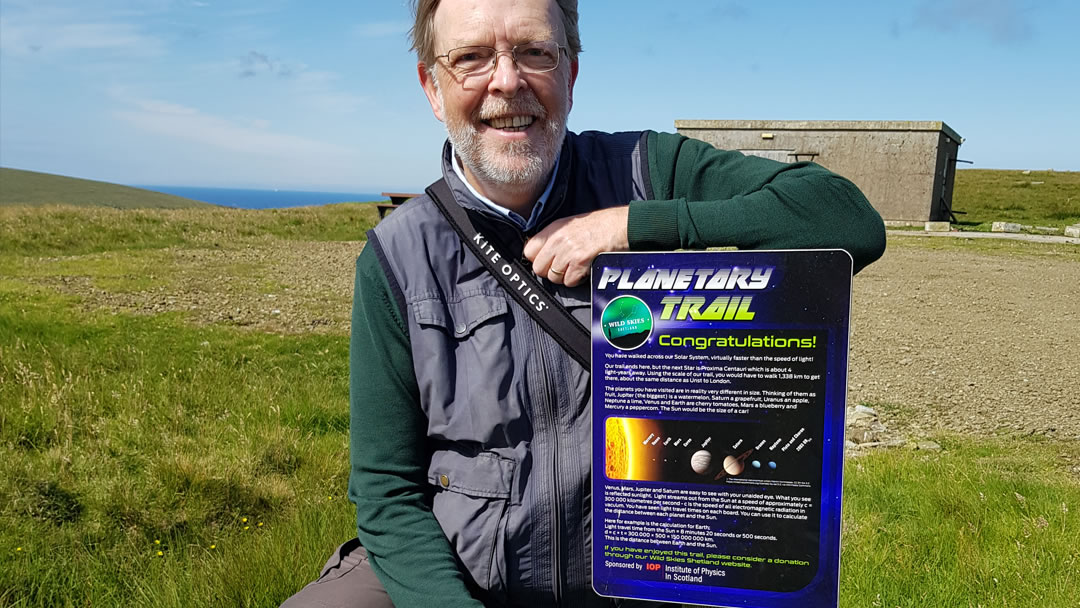
As well as the photographic display, Unst Heritage Centre also houses virtual reality headsets, so visitors can see the northern lights even in the summer and on cloudy nights in winter.
Unst may soon be launching rockets – the Saxa Vord space port is in the developmental stages. Wild Skies Shetland is completely independent from the Spaceport but we expect ‘space tourists’ will be interested in what we have to offer.
Another space fact that not many people know is that there is an asteroid which orbits in the asteroid belt between Jupiter and Mars called Unst (Asteroid 394445 Unst). Wild Skies has made a film – An Asteroid called Unst – which was recently shown at Shetland’s film festival ‘Screenplay’. It follows the asteroid in her journey to visit the island, and she meets a variety of characters along the way including a ghost, some Vikings and a giant bonxie (great skua).
Not many other islands can say they have an asteroid named after them!
Q. Have you received much support in developing Wild Skies Shetland?
A. Yes, we are all volunteers in Wild Skies Shetland, and we have received all sorts of different forms of help from folk in Unst and beyond. The Shetland Coastal Communities Fund, Highlands and Islands Enterprise, The Institute of Physics Scotland and the National Lottery Community Fund have provided funds. We have also been sponsored by local businesses in an effort to help Wild Skies grow and flourish.
 By Victoria Dixon
By Victoria DixonOrkney and Shetland fanatic, likes to capture life through a lens, loves creating, eclectic taste in music, enjoys being a Mum; would secretly love to be a star of the West End!
Pin it!